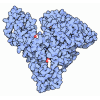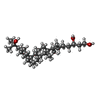[English] 日本語
 Yorodumi
Yorodumi- PDB-7oxz: VDR complex with a side-chain hydroxylated derivative of lithocho... -
+ Open data
Open data
- Basic information
Basic information
| Entry | Database: PDB / ID: 7oxz | ||||||
|---|---|---|---|---|---|---|---|
| Title | VDR complex with a side-chain hydroxylated derivative of lithocholic acid | ||||||
 Components Components |
| ||||||
 Keywords Keywords | TRANSCRIPTION / nuclear recptor / agonist | ||||||
| Function / homology |  Function and homology information Function and homology informationheart jogging / Vitamin D (calciferol) metabolism / SUMOylation of intracellular receptors / vitamin D binding / calcitriol binding / lithocholic acid binding / labyrinthine layer morphogenesis / positive regulation of transcription from RNA polymerase II promoter by galactose / regulation of thyroid hormone receptor signaling pathway / positive regulation of female receptivity ...heart jogging / Vitamin D (calciferol) metabolism / SUMOylation of intracellular receptors / vitamin D binding / calcitriol binding / lithocholic acid binding / labyrinthine layer morphogenesis / positive regulation of transcription from RNA polymerase II promoter by galactose / regulation of thyroid hormone receptor signaling pathway / positive regulation of female receptivity / NR1H2 & NR1H3 regulate gene expression to control bile acid homeostasis / male mating behavior / hematopoietic stem cell proliferation / hypothalamus development / heart looping / cellular response to Thyroglobulin triiodothyronine / Synthesis of bile acids and bile salts / progesterone receptor signaling pathway / Synthesis of bile acids and bile salts via 27-hydroxycholesterol / Endogenous sterols / Synthesis of bile acids and bile salts via 7alpha-hydroxycholesterol / response to retinoic acid / estrous cycle / nuclear retinoid X receptor binding / histone acetyltransferase activity / cellular response to hormone stimulus / Recycling of bile acids and salts / Transcriptional regulation of brown and beige adipocyte differentiation by EBF2 / calcium ion homeostasis / histone acetyltransferase / NR1H3 & NR1H2 regulate gene expression linked to cholesterol transport and efflux / intracellular receptor signaling pathway / estrogen receptor signaling pathway / lactation / : / positive regulation of adipose tissue development / Regulation of lipid metabolism by PPARalpha / peroxisome proliferator activated receptor signaling pathway / positive regulation of neuron differentiation / regulation of cellular response to insulin stimulus / BMAL1:CLOCK,NPAS2 activates circadian expression / ossification / SUMOylation of transcription cofactors / Activation of gene expression by SREBF (SREBP) / response to progesterone / cerebellum development / nuclear estrogen receptor binding / nuclear receptor binding / RNA polymerase II transcription regulatory region sequence-specific DNA binding / hippocampus development / mRNA transcription by RNA polymerase II / Heme signaling / Transcriptional activation of mitochondrial biogenesis / PPARA activates gene expression / Cytoprotection by HMOX1 / cerebral cortex development / Transcriptional regulation of white adipocyte differentiation / RNA polymerase II transcription regulator complex / male gonad development / nuclear receptor activity / : / response to estradiol / HATs acetylate histones / MLL4 and MLL3 complexes regulate expression of PPARG target genes in adipogenesis and hepatic steatosis / transcription regulator complex / Estrogen-dependent gene expression / cell differentiation / transcription coactivator activity / protein dimerization activity / positive regulation of apoptotic process / RNA polymerase II cis-regulatory region sequence-specific DNA binding / DNA-templated transcription / chromatin binding / regulation of DNA-templated transcription / chromatin / positive regulation of DNA-templated transcription / protein-containing complex binding / negative regulation of transcription by RNA polymerase II / positive regulation of transcription by RNA polymerase II / protein-containing complex / zinc ion binding / nucleoplasm / nucleus / plasma membrane / cytoplasm / cytosol Similarity search - Function | ||||||
| Biological species |   Homo sapiens (human) Homo sapiens (human) | ||||||
| Method |  X-RAY DIFFRACTION / X-RAY DIFFRACTION /  SYNCHROTRON / SYNCHROTRON /  MOLECULAR REPLACEMENT / Resolution: 2.2 Å MOLECULAR REPLACEMENT / Resolution: 2.2 Å | ||||||
 Authors Authors | Rochel, N. | ||||||
 Citation Citation |  Journal: Bioorg.Chem. / Year: 2021 Journal: Bioorg.Chem. / Year: 2021Title: Design, synthesis and evaluation of side-chain hydroxylated derivatives of lithocholic acid as potent agonists of the vitamin D receptor (VDR). Authors: Gonzalez, C.M. / Gaikwad, S. / Lasanta, G. / Loureiro, J. / Nilsson, N. / Peluso-Iltis, C. / Rochel, N. / Mourino, A. | ||||||
| History |
|
- Structure visualization
Structure visualization
| Structure viewer | Molecule:  Molmil Molmil Jmol/JSmol Jmol/JSmol |
|---|
- Downloads & links
Downloads & links
- Download
Download
| PDBx/mmCIF format |  7oxz.cif.gz 7oxz.cif.gz | 120.4 KB | Display |  PDBx/mmCIF format PDBx/mmCIF format |
|---|---|---|---|---|
| PDB format |  pdb7oxz.ent.gz pdb7oxz.ent.gz | 91.9 KB | Display |  PDB format PDB format |
| PDBx/mmJSON format |  7oxz.json.gz 7oxz.json.gz | Tree view |  PDBx/mmJSON format PDBx/mmJSON format | |
| Others |  Other downloads Other downloads |
-Validation report
| Summary document |  7oxz_validation.pdf.gz 7oxz_validation.pdf.gz | 380.3 KB | Display |  wwPDB validaton report wwPDB validaton report |
|---|---|---|---|---|
| Full document |  7oxz_full_validation.pdf.gz 7oxz_full_validation.pdf.gz | 382.4 KB | Display | |
| Data in XML |  7oxz_validation.xml.gz 7oxz_validation.xml.gz | 11.5 KB | Display | |
| Data in CIF |  7oxz_validation.cif.gz 7oxz_validation.cif.gz | 15.1 KB | Display | |
| Arichive directory |  https://data.pdbj.org/pub/pdb/validation_reports/ox/7oxz https://data.pdbj.org/pub/pdb/validation_reports/ox/7oxz ftp://data.pdbj.org/pub/pdb/validation_reports/ox/7oxz ftp://data.pdbj.org/pub/pdb/validation_reports/ox/7oxz | HTTPS FTP |
-Related structure data
| Related structure data | 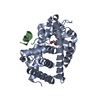 7oy4C 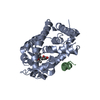 2hc4S S: Starting model for refinement C: citing same article ( |
|---|---|
| Similar structure data |
- Links
Links
- Assembly
Assembly
| Deposited unit | 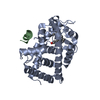
| ||||||||
|---|---|---|---|---|---|---|---|---|---|
| 1 | 
| ||||||||
| Unit cell |
|
- Components
Components
| #1: Protein | Mass: 34060.672 Da / Num. of mol.: 1 Source method: isolated from a genetically manipulated source Source: (gene. exp.)   |
|---|---|
| #2: Protein/peptide | Mass: 1776.072 Da / Num. of mol.: 1 / Source method: obtained synthetically / Source: (synth.)  Homo sapiens (human) / References: UniProt: Q15788, histone acetyltransferase Homo sapiens (human) / References: UniProt: Q15788, histone acetyltransferase |
| #3: Chemical | ChemComp-2UI / ( |
| #4: Water | ChemComp-HOH / |
| Has ligand of interest | Y |
-Experimental details
-Experiment
| Experiment | Method:  X-RAY DIFFRACTION / Number of used crystals: 1 X-RAY DIFFRACTION / Number of used crystals: 1 |
|---|
- Sample preparation
Sample preparation
| Crystal | Density Matthews: 2.34 Å3/Da / Density % sol: 47.33 % |
|---|---|
| Crystal grow | Temperature: 293 K / Method: vapor diffusion, sitting drop / pH: 6.5 Details: 50 mM Bis-Tris pH 6.5, 1.6 M lithium sulfate and 50 mM magnesium sulfate |
-Data collection
| Diffraction | Mean temperature: 100 K / Serial crystal experiment: N |
|---|---|
| Diffraction source | Source:  SYNCHROTRON / Site: SYNCHROTRON / Site:  SOLEIL SOLEIL  / Beamline: PROXIMA 2 / Wavelength: 0.98 Å / Beamline: PROXIMA 2 / Wavelength: 0.98 Å |
| Detector | Type: DECTRIS EIGER X 4M / Detector: PIXEL / Date: Jun 4, 2021 |
| Radiation | Protocol: SINGLE WAVELENGTH / Monochromatic (M) / Laue (L): M / Scattering type: x-ray |
| Radiation wavelength | Wavelength: 0.98 Å / Relative weight: 1 |
| Reflection | Resolution: 2.2→43.9 Å / Num. obs: 14810 / % possible obs: 80.18 % / Redundancy: 2 % / CC1/2: 1 / Net I/σ(I): 21.06 |
| Reflection shell | Resolution: 2.2→2.279 Å / Num. unique obs: 458 / CC1/2: 0.818 |
- Processing
Processing
| Software |
| |||||||||||||||||||||||||||||||||||||||||||||||||||||||||||||||||||||||||||||||||||||||||||||||||||||||||||||||||||||||||||||||||||||||||||||||||||||||||||||||||||||||||||||||
|---|---|---|---|---|---|---|---|---|---|---|---|---|---|---|---|---|---|---|---|---|---|---|---|---|---|---|---|---|---|---|---|---|---|---|---|---|---|---|---|---|---|---|---|---|---|---|---|---|---|---|---|---|---|---|---|---|---|---|---|---|---|---|---|---|---|---|---|---|---|---|---|---|---|---|---|---|---|---|---|---|---|---|---|---|---|---|---|---|---|---|---|---|---|---|---|---|---|---|---|---|---|---|---|---|---|---|---|---|---|---|---|---|---|---|---|---|---|---|---|---|---|---|---|---|---|---|---|---|---|---|---|---|---|---|---|---|---|---|---|---|---|---|---|---|---|---|---|---|---|---|---|---|---|---|---|---|---|---|---|---|---|---|---|---|---|---|---|---|---|---|---|---|---|---|---|---|
| Refinement | Method to determine structure:  MOLECULAR REPLACEMENT MOLECULAR REPLACEMENTStarting model: 2HC4 Resolution: 2.2→43.86 Å / SU ML: 0.31 / Cross valid method: THROUGHOUT / σ(F): 1.33 / Phase error: 30.41 / Stereochemistry target values: ML
| |||||||||||||||||||||||||||||||||||||||||||||||||||||||||||||||||||||||||||||||||||||||||||||||||||||||||||||||||||||||||||||||||||||||||||||||||||||||||||||||||||||||||||||||
| Solvent computation | Shrinkage radii: 0.9 Å / VDW probe radii: 1.11 Å / Solvent model: FLAT BULK SOLVENT MODEL | |||||||||||||||||||||||||||||||||||||||||||||||||||||||||||||||||||||||||||||||||||||||||||||||||||||||||||||||||||||||||||||||||||||||||||||||||||||||||||||||||||||||||||||||
| Displacement parameters | Biso max: 136.35 Å2 / Biso mean: 53.5989 Å2 / Biso min: 21.07 Å2 | |||||||||||||||||||||||||||||||||||||||||||||||||||||||||||||||||||||||||||||||||||||||||||||||||||||||||||||||||||||||||||||||||||||||||||||||||||||||||||||||||||||||||||||||
| Refinement step | Cycle: final / Resolution: 2.2→43.86 Å
| |||||||||||||||||||||||||||||||||||||||||||||||||||||||||||||||||||||||||||||||||||||||||||||||||||||||||||||||||||||||||||||||||||||||||||||||||||||||||||||||||||||||||||||||
| LS refinement shell | Refine-ID: X-RAY DIFFRACTION / Rfactor Rfree error: 0 / Total num. of bins used: 11
| |||||||||||||||||||||||||||||||||||||||||||||||||||||||||||||||||||||||||||||||||||||||||||||||||||||||||||||||||||||||||||||||||||||||||||||||||||||||||||||||||||||||||||||||
| Refinement TLS params. | Method: refined / Refine-ID: X-RAY DIFFRACTION
| |||||||||||||||||||||||||||||||||||||||||||||||||||||||||||||||||||||||||||||||||||||||||||||||||||||||||||||||||||||||||||||||||||||||||||||||||||||||||||||||||||||||||||||||
| Refinement TLS group |
|
 Movie
Movie Controller
Controller


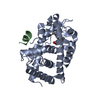
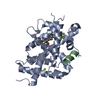
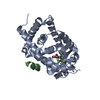


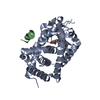

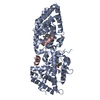






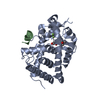
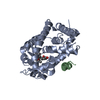
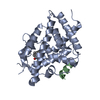
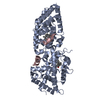
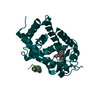
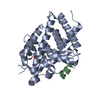
 PDBj
PDBj






